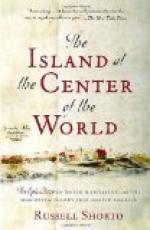But after a few years it was found that the new country was a much richer place than had been supposed. Shipload after shipload of otter and beaver skins were sent across the ocean and still there were otters and beavers without number. The fur-traders were growing rich, and after a few years there came a decided change, when a new company was formed in Holland; a great body of men this time, who had a vast amount of money to build ships and fit them out. This organization was the West India Company, and was to battle with Spain by land and by sea (for the Netherlands was at war with Spain) and was to carry on trade with the West Indies, just as the East India Company carried on trade with the East Indies. As the West Indies included every country that could be reached by sailing west from Holland, you will see that all the Dutch land in America, which land was called New Netherland, came under the control of this new company.
The territory called New Netherland was the country along the Atlantic Ocean which now makes up the States of New Jersey, New York, and Connecticut. But its limits at this time were uncertain as it extended inland as far as the Company might care to send their colonists.
Within a few years, the seventy ships sailing under the flag of the West India Company, fought great battles with the Spaniards, and won almost every one of them. There were branches of the Company in seven cities of Holland, and the branch in Amsterdam had charge of New Netherland. So it will be only of the doings of this branch that we shall read. Colonists were to be carried to New Netherland from Holland; farms were to be laid out and cultivated; cities were to be built, and the West India Company was to have absolute control over all, and was to rule all the people. To do these things they had authority from the States-General of Holland, which was the name given to the men who made the laws for that country. The Company was to make regular reports to the States-General, and tell of the growth of the colony and the progress of the people in it. But as the years went on the Company was not as particular as it should have been about what it told the States-General.
[Illustration: Hall of the States-General of Holland.]
It was not until the West India Company took charge of New Netherland that it was decided to make the settlement on the Island of Manhattan a city. Up to this time it had been merely a trading station. In order to build up a city, the Company knew that it would be necessary to send people in sufficient numbers so that no matter how many were killed by the Indians the settlement would not be wiped out. Many inducements were offered, and men with their families soon began to flock to New Netherland. With the ship that brought the first families was Cornelius Jacobsen May, who was to live on the Island of Manhattan and look after affairs for the Company. Rude houses were set up about the fort, and the first street came into existence. This is now called Pearl Street.




